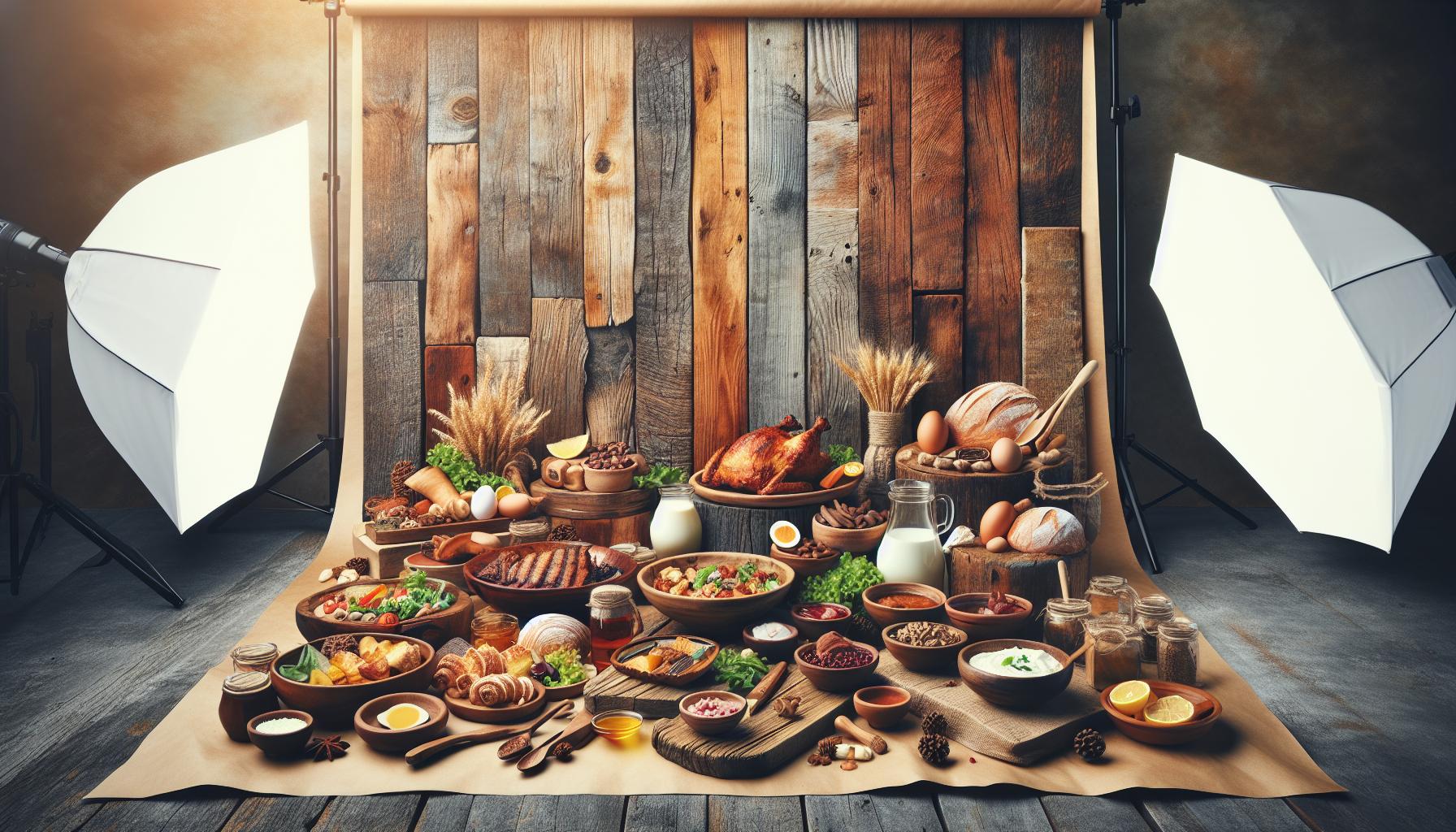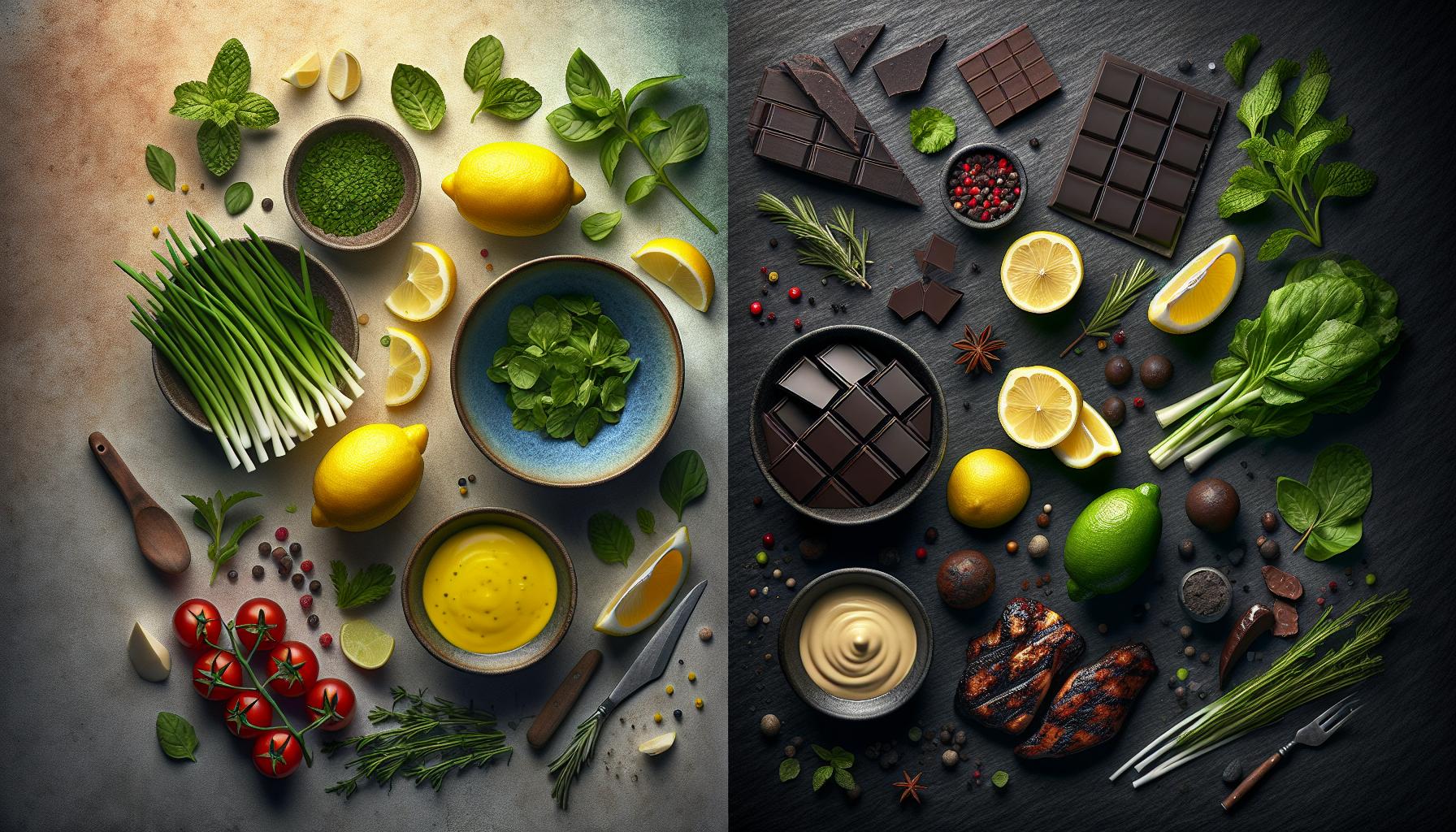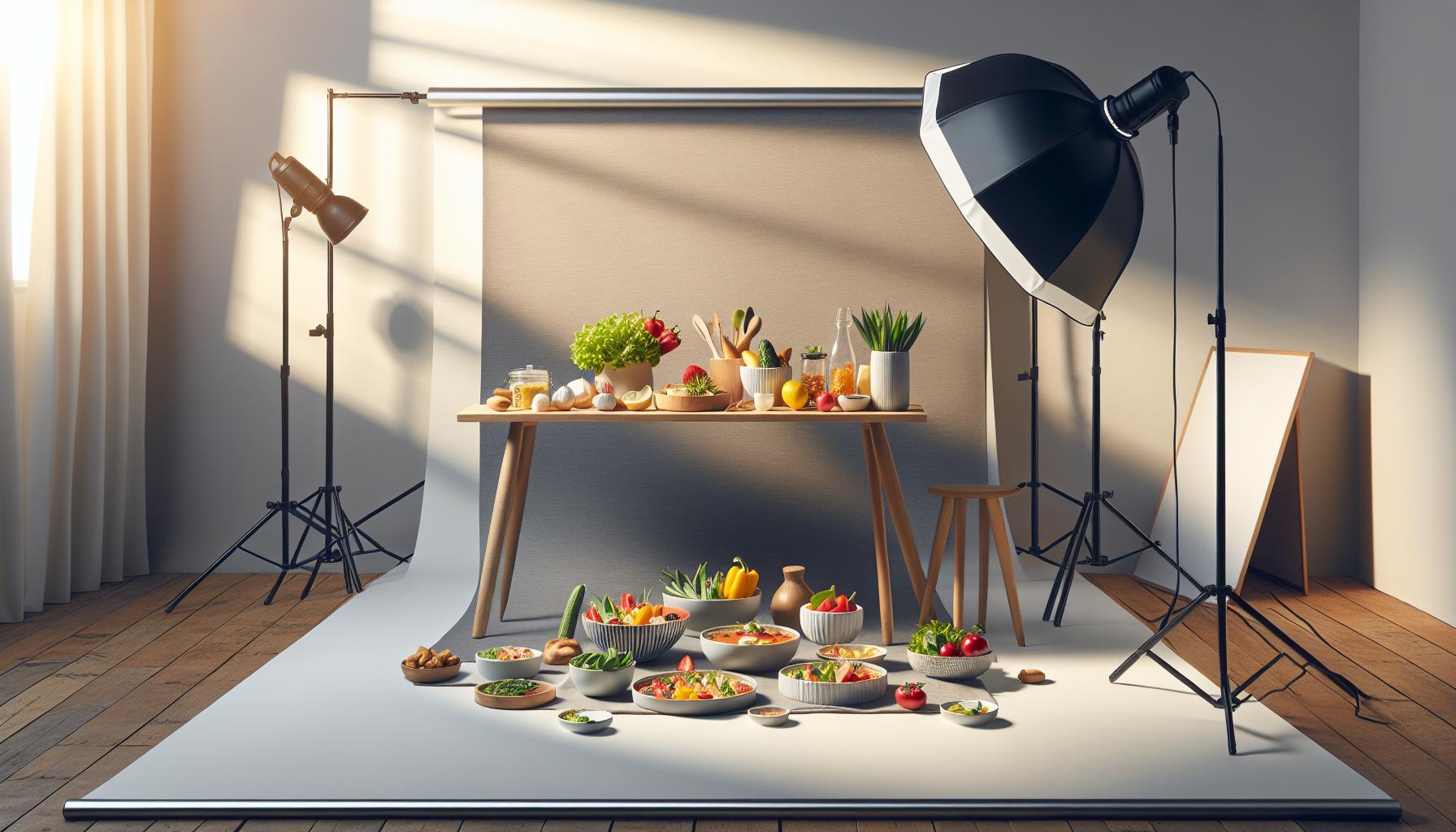Ever wondered why some food photos make your mouth water while others fall flat? The secret sauce often lies in the backdrop. Food photographers know that the perfect background can transform an ordinary burger shot into a masterpiece that belongs in a glossy magazine.
Creating stunning food photography isn’t just about the dish itself – it’s about setting the stage for your culinary star to shine. From rustic wooden boards to sleek marble surfaces the right backdrop acts like a supporting actor that enhances the main character without stealing the show. It’s what separates the amateur shots from the ones that rake in thousands of likes on Instagram and make viewers reach for their wallets at restaurants.
Backdrop For Food Photography
Backdrop for food photographycreate visual depth that transforms ordinary food shots into compelling narratives. A carefully selected backdrop establishes the mood through color psychology, texture variations, and lighting interactions.
Professional photographers consider backdrops essential elements for:
- Enhancing food colors through complementary background tones
- Creating depth perception with textured surfaces
- Establishing brand consistency across image collections
- Controlling unwanted reflections light bounce
- Highlighting specific food elements through contrast
Backdrops influence viewer perception in distinct ways:
- Dark backgrounds make light-colored foods appear more vibrant
- Rustic textures add authenticity to homestyle dishes
- Clean minimalist surfaces emphasize modern plating
- Seasonal materials connect dishes to specific times of year
The impact of backdrops extends beyond aesthetics into practical benefits:
- Higher engagement rates on social media platforms
- Increased menu item sales when used in restaurant marketing
- Better portfolio cohesion for professional photographers
- Improved brand recognition through consistent styling
- Enhanced perceived value of food products
Research shows food images with coordinated backdrops receive 45% more engagement compared to those without intentional backgrounds. Restaurant menus featuring professionally styled food photos with appropriate backdrops drive 30% higher sales of featured items.
| Backdrop Type | Engagement Increase | Sales Impact |
|---|---|---|
| Coordinated | 45% | 30% |
| Unplanned | 12% | 8% |
| None | Baseline | Baseline |
Popular Types of Backdrop For Food Photography

Professional food photographers select specific backdrop for food photography materials to create distinct moods and enhance food presentation. Each surface type offers unique characteristics that complement different food styles and photography objectives.
Wooden Surfaces and Boards
Wooden backdrops create rustic charm and natural warmth in food photography. Weathered barn wood adds authenticity to comfort food images while smooth, polished surfaces complement modern cuisine presentations. Oak boards provide rich grain patterns for visual interest, pine surfaces offer lighter tones for bright compositions, and reclaimed wood introduces character through distressed textures. Many photographers maintain collections of wooden boards in varying colors, from deep mahogany to whitewashed finishes, enabling versatile shooting options. Food photographers often use sealed wooden surfaces to prevent staining from spills during shoots.
Textured Vinyl Backdrops
Vinyl backdrops combine durability with portable convenience for food photography sessions. These surfaces feature printed patterns that mimic concrete, metal or fabric textures at a fraction of the real materials’ weight. Photography-specific vinyl backdrops include anti-glare coatings to minimize unwanted reflections. Double-sided versions offer two distinct textures per sheet, maximizing styling options. Professional-grade vinyl resists water damage, cleans easily between shots, and rolls up for transport. Custom-printed vinyl backdrops enable exact color matching for brand consistency across photo series.
Marble and Stone Surfaces
Marble surfaces create elegant, high-end aesthetics in food photography compositions. White Carrara marble provides classic luxury appeal while darker varieties like nero marquina offer dramatic contrast. Stone surfaces maintain consistent temperatures, benefiting ice cream and frozen dessert photography. Polished granite introduces subtle speckled patterns that add depth without overwhelming food subjects. Slate boards create moody atmospheres with their deep charcoal tones. Natural stone surfaces reflect light effectively, producing sophisticated highlights that enhance food presentation. Many photographers use marble-look ceramic tiles as lightweight alternatives to real stone.
Choosing the Right Colors and Textures

Color selection creates significant impact in food photography by influencing mood perception directing viewer attention to the main subject. Texture combinations add depth creating visual interest that enhances the overall composition.
Light vs Dark Backdrops
Light backgrounds reflect more light onto food creating bright airy images suitable for fresh produce pastries citrus dishes. White surfaces highlight vibrant colors making yellow lemons pop green herbs appear crisp red tomatoes look more appetizing. Dark backdrops absorb light creating dramatic moody compositions ideal for rich foods like chocolate wine grilled meats. Black slate charcoal gray navy blue surfaces enhance contrast making light-colored foods stand out creating sophisticated elegant imagery.
Complementary Color Selection
Complementary colors enhance food presentation by creating visual harmony balance between the subject backdrop. Blue backgrounds intensify orange-tinted foods like salmon grilled peaches roasted squash. Green surfaces complement red foods including strawberries tomatoes meat dishes. Purple backdrops enhance yellow foods such as corn lemons cheese plates. Gray neutral backgrounds work universally allowing food colors to remain authentic without competing for attention. Color wheel principles guide photographers in selecting backgrounds that enhance specific food types creating maximum visual impact.
Setting Up Your Food Photography Backdrop

Creating an effective food photography setup involves positioning the backdrop to maximize visual impact while maintaining practical functionality. The right setup transforms ordinary food shots into professional-quality images through careful attention to placement, lighting, and technical considerations.
Proper Placement and Lighting
Positioning the backdrop at a 90-degree angle creates a seamless transition between the horizontal and vertical surfaces. Natural light from a side window illuminates food subjects optimally when placed 45 degrees from the backdrop. Professional photographers position backdrops 18-24 inches away from walls to prevent unwanted shadows. LED panels set at 45-degree angles complement natural lighting while eliminating harsh shadows. A reflector placed opposite the main light source fills in dark areas, creating balanced exposure across the frame.
Avoiding Common Setup Mistakes
Using wrinkled or dirty backdrops creates distracting elements that draw attention away from the food subject. Improper securing leads to backdrop movement during shooting, resulting in inconsistent angles across photo sets. Placing backdrops too close to walls causes shadow contamination from surrounding objects. Incorrect light placement creates unwanted reflections on glossy surfaces like marble or metal backdrops. Failing to level the backdrop surface produces skewed perspectives that make food items appear tilted. Mixed lighting temperatures between natural and artificial sources create uneven color casts across the backdrop surface.
DIY Food Photography Backdrop Ideas
Creating professional-looking food photography backdrops costs less with DIY alternatives. These custom solutions offer unique textures patterns while maintaining high-quality results.
Budget-Friendly Materials
Foam boards provide lightweight versatile backdrops for under $10 each. Contact paper transforms ordinary surfaces with marble wood granite patterns at $15-20 per roll. Craft paper rolls in various colors cost $5-8 each creating seamless backgrounds. Fabric remnants from craft stores offer textured options at $3-5 per yard. Tile samples from home improvement stores establish elegant surfaces for $2-4 per piece. Old cutting boards painted boards salvaged wood pieces serve as rustic backdrops at minimal cost.
- MDF boards for stable flat surfaces
- Plywood sheets for larger setups
- Hardboard panels for lightweight options
- Canvas boards for texture variety
- Foam core for portable backgrounds
Best Practices for Using Backdrop for Food Photography
Proper lighting techniques maximize backdrop effectiveness in food photography. Position the main light source at a 45-degree angle to minimize unwanted shadows. Keep backdrops clean from dust, smudges or fingerprints before each shoot.
Storage methods affect backdrop longevity:
- Store flat to prevent warping
- Use protective sleeves between vinyl surfaces
- Keep in climate controlled environments
- Label each backdrop with size specifications
- Stack similar materials together
Composition guidelines enhance visual impact:
- Leave 2-3 inches of backdrop visible around food items
- Maintain consistent angles across photo series
- Position props strategically without overcrowding
- Create depth by varying distances between elements
- Align backdrop patterns parallel to frame edges
Surface preparation improves image quality:
- Steam or iron fabric backdrops to remove wrinkles
- Clean glossy surfaces with microfiber cloths
- Test backdrop reflectivity before shooting
- Secure loose edges with clamps or tape
- Check for distracting seams or imperfections
Professional photographers rotate backdrops based on:
| Factor | Recommended Frequency |
|---|---|
| Heavy Use | Every 3-4 months |
| Normal Use | Every 6-8 months |
| Light Use | Every 12 months |
| Surface Type | Based on wear |
Maintaining backdrop libraries enables efficient shoots. Organize materials by color, texture or size for quick access. Document successful backdrop combinations with specific dishes or styles. Test new backdrops under various lighting conditions before client shoots.
Foundation of Exceptional Food Photography
A thoughtfully chosen backdrop serves as the foundation of exceptional food photography. It’s not just about making food look appealing; it’s about creating a complete visual story that resonates with viewers and drives engagement.
Whether using professional materials or DIY solutions photographers can transform ordinary food shots into captivating images that stand out in today’s digital landscape. The right backdrop choice combined with proper setup techniques and maintenance ensures consistently stunning results that benefit both commercial and artistic endeavors.
Success in food photography ultimately comes down to understanding how backdrops work with lighting color and composition to create images that not only showcase the food but also evoke emotion and drive action.

